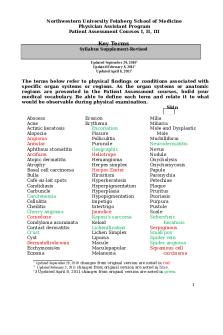Pulmonology - ARDS - Clinical Practicum II A PDF

| Title | Pulmonology - ARDS - Clinical Practicum II A |
|---|---|
| Author | Ana de Luca |
| Course | Clinical Practicum II A |
| Institution | University of Suffolk |
| Pages | 1 |
| File Size | 160.9 KB |
| File Type | |
| Total Downloads | 103 |
| Total Views | 140 |
Summary
Clinical Practicum II A...
Description
Pulmonology [ARDS] Pathogenesis and Introduction ARDS is a noncardiogenic pulmonary edema that results from increased permeability of capillaries permitting the transudation of fluid from capillaries into the interstitium. This causes a barrier to diffusion preventing gas exchange resulting in a hypoxemia. It looks and feels like CHF but the cardiovascular function is intact, hydrostatic pressures are normal (meaning that the capillary wedge pressure is normal), and it’s the capillary permeability that drives disease. Too many leaky capillaries then leads to pulmonary edema and alveolar derecruitment.
Normal gas exchange and no leaky capillaries in the normal state
Impaired oxygenation as a product of increased diffusion barrier from leaky capillaries in ARDS
Presentation This is a patient with pulmonary edema (SOB, cough, crackles) and a nasty looking CXR (bilateral white out). The patient is also one without a reason for CHF (MI, HTN, Arrhythmia, Fluid) and has instead a really sick presentation (as in the ICU). To cause capillary permeability to increase so significantly requires GNR septicemia, burns, TRALI, or drowning. These patients usually present to the hospital then crash in the ICU, rather than a person presenting in florid pulmonary edema. Diagnosis A patient with a systemic disease and pulmonary edema (especially someone volume down or hypotensive) is likely enough for the diagnosis. A CXR will show white out bilaterally. However, to definitively diagnose ARDS vs CHF a measurement of capillary-wedge pressures via a Swan-Ganz cath is required. This will show a decreased or normal wedge (no backup of fluid) and an increased or Normal LV function (not heart failure). Both findings are in direct contradiction to CHF. Generally, it’s not done for CHF (patients aren’t sick enough to get a Swan-Ganz), though there are certainly HF patients sick enough to make it to the ICU. A patient with ARDS will be intubated, full of lines, and ripe to do the assessment on. A PaO2 to FiO2 ration will be < 200. Treatment Intubation and Oxygenation are crucial as first line therapy. With intubation, application of PEEP increases the interstitial pressures, forcing the fluid back into the capillaries. The vessels remain leaky and only close once the underlying disease is corrected. Monitoring/Complications When someone’s put on PEEP it’s possible to induce barotrauma or induce pneumothorax. If the patient suddenly presents with worsening SOB after PEEP, suspect barotrauma. However, if a patient becomes hypotensive and has a mediastinal shift (tracheal deviation) a tension pneumo should be suspected. Confirm the diagnosis with a CXR and treat with needle decompression and chest tube.
PEEP provides alveolar recruitment and improves diffusion of oxygen by reducing diffusion barrier
Alveolus
Alveolus Blood
Blood Gas Exchange Ø Impaired
Edema impairs Gas Exchange
J = K [Pcap – Pint ) – (πcap – πint)] Fluid movement across a capillary ARDS causes ↑ in K, fluid leaks out PEEP causes ↑ in Pint, pushes fluid back in
Exacerbating Factors Chest X-Ray Capillary Wedge LV Function Treatment
CHF HTN, MI Fluid Overload Bi Pleural Effusions Bi Hazy Infiltrates ↑ (25) ↓ Diuresis, Control of HTN, PEEP if severe
ARDS Sepsis, Burns, Drowning, TRALI Total White Out Severe Bi Infiltrates Normal (10) Normal PEEP Intubation Tx Underlying Dz
! © OnlineMedEd. http://www.onlinemeded.org...
Similar Free PDFs

Practicum Journal at clinical
- 5 Pages

Memoria de prácticas practicum II
- 47 Pages

ASKEP ARDS
- 14 Pages

ARDS RESPIRATORY DISEASE
- 5 Pages

Wisselstromen practicum
- 11 Pages

Practicum - Strategiekaart
- 2 Pages

Practicum 5
- 4 Pages

Practicum IR
- 4 Pages

Practicum: Wrijvingskracht
- 5 Pages

ARDS Case Study - Student Copy
- 4 Pages
Popular Institutions
- Tinajero National High School - Annex
- Politeknik Caltex Riau
- Yokohama City University
- SGT University
- University of Al-Qadisiyah
- Divine Word College of Vigan
- Techniek College Rotterdam
- Universidade de Santiago
- Universiti Teknologi MARA Cawangan Johor Kampus Pasir Gudang
- Poltekkes Kemenkes Yogyakarta
- Baguio City National High School
- Colegio san marcos
- preparatoria uno
- Centro de Bachillerato Tecnológico Industrial y de Servicios No. 107
- Dalian Maritime University
- Quang Trung Secondary School
- Colegio Tecnológico en Informática
- Corporación Regional de Educación Superior
- Grupo CEDVA
- Dar Al Uloom University
- Centro de Estudios Preuniversitarios de la Universidad Nacional de Ingeniería
- 上智大学
- Aakash International School, Nuna Majara
- San Felipe Neri Catholic School
- Kang Chiao International School - New Taipei City
- Misamis Occidental National High School
- Institución Educativa Escuela Normal Juan Ladrilleros
- Kolehiyo ng Pantukan
- Batanes State College
- Instituto Continental
- Sekolah Menengah Kejuruan Kesehatan Kaltara (Tarakan)
- Colegio de La Inmaculada Concepcion - Cebu





